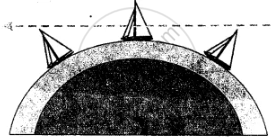Advertisements
Advertisements
प्रश्न
Study the picture and answer the questions that follow.

(a) What does the picture show you about the earth?
(b) State briefly the Bedford Level Experiment.
(c) The sun rises and sets at different times in different places. What does the statement show the shape of the earth?
(d) In what way is the earth’s atmosphere beneficial to mankind?
उत्तर
(a) The picture shows the spherical shape of the earth.
(b) Three pillars of equal height were put along the Bedford Level canal area in England each at 5 km. interval. After observation, it came to know that the middle pole was higher than the sideward poles. This proved that the earth’s surface was curved and the earth is a spherical body.
(c) The times of sunset and sunrise are different in the different parts of the earth because the earth moves from west to east and the places situated in the east get sunrise first. Japan is called the land of the rising sun, as it is in the eastern-most part of the Eastern Hemisphere and the date starts from the Eastern Hemisphere. It proves that the earth is spherical.
(d) The atmosphere is indispensable for life on earth, as it provides air to inhale; rainfall and freshwater bodies after the hydrological cycle. Moreover, it absorbs the extremely hot ultraviolet rays of the sun and makes the temperature ideal on earth. Other planets are either very hot or very cold due to the absence of an atmosphere.
APPEARS IN
संबंधित प्रश्न
Short Answer Question:
What is the earth’s mean temperature? State its one advantage.
Short Answer Question:
Name the two sources of heat in the interior of the earth.
Short Answer Question:
What is a planet?
How much time does a ray of sunlight take to reach the Earth?
Write a short note on the two planets nearest to the sun.
Who am I?
You can see me from the earth but the lighted part of me that you see changes every day.
Who am I?
I am the nearest star to the earth.
The line which divides day and night on the Earth’s surface is ______.
The living sphere.
Distinguish between Rotation and Revolution?
